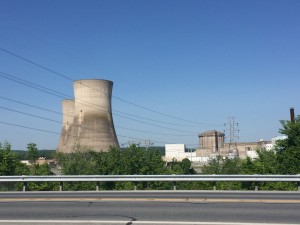Three Mile Island Experience
May 26, 2016

On Tuesday our group had the privilege to be escorted through the Three Mile Island nuclear power plant. We got to see everything from the security measures to the generators to the reactor control room. Most of the technology that is used to control the reactor is analog, as it would have been when the plant was built and when the accident occurred in 1979. The room is full of switches, nobs and buttons but the most striking thing about it is all of the screens on top of the main panel that light up when something goes wrong with in the reactor building. After seeing how complicated it is and how many people it takes to keep things running (3 teams of workers!) it makes what happened at the plant in 1979 completely understandable. To have to figure out exactly what to do with the reactor in a split second while having to deal with so much sensory input and confusing controls must inevitably lead to a disaster. I was also surprised at how much security Exelon had employed at the plant. There were more security guards and they were far more heavily armed than any other security I’ve seen, even at government buildings in Washington, D.C. Another thing about the plant that I wasn’t expecting was just how clean it was. I don’t remember seeing any dirt or oil or grease on the floor nor on the machines. I assume this is for safety purposes. I’m sure the plant has been extra diligent at keeping their facilities in tip top shape since the accident.
While using nuclear fusion to generate power is certainly the cleanest form of energy in terms of its fuel use (i.e. water vapor is the only immediate product of the reaction), I still think there are some caveats involved with it that should be taken into consideration. One of these is the spent fuel and how it is dealt with. The spent uranium fuel rods used to power the reactor are disposed of after they are depleted by being kept in a pool on-site (due to political gridlock relating to their storage). These spent fuel rods do not seem to have the ultra-high level of monitoring and security as the reactor itself is despite the fact that they are still highly radioactive and will remain so for many centuries. We must find a way to securely store them without causing harm to the environment. Burying them in a storage facility dug into Yucca Mountain in Nevada seems to be the best solution at present but the facility remains empty, waiting for its use to be green-lighted by Washington. Unfortunately, this highly dangerous spent fuel is, and most likely will remain, sitting in a pool of water at the same nuclear power plants that claim to be so safe.
Leave a Reply